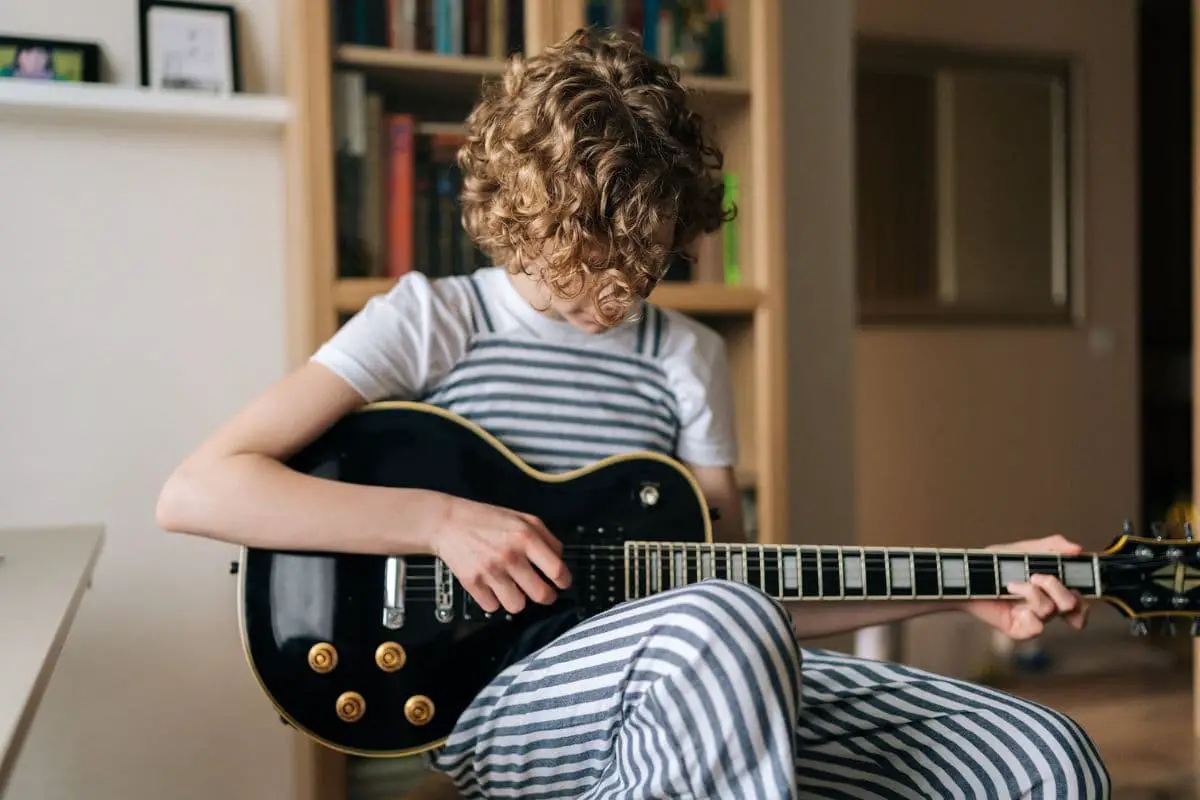Playing the electric guitar can be a bit loud if you have a big amp on the max settings. The last thing you want to do is bother your apartment neighbors or get complaints from the front office. However, there are plenty of ways to play your instrument without having to disturb the people living around you.
To practice electric guitar in an apartment, practice it in a room without shared walls, keep the amp off the floor, and plug a pair of headphones into the output jack. You can also put a thick rug and soundproofing foam around the room to prevent the sounds from getting through the walls.
In this article, you’ll learn all about how to practice the electric guitar in an apartment. You’ll also find a few ways to know the right place and time to play the instrument.
👇😀👇NOTE👇😀👇
If you want to find out what my recommended guitar gear is, then here is what I recommend on Amazon:
- Fender Cutaway Acoustic-Electric Guitar Bundle (MY FAVORITE GUITAR)
- Snark SN-8 Super Tight All Instrument Tuner (Easiest Tuner I’ve Used😏)
- 6 String Acoustic Guitar Capo (Best CAPO for quick changes)
- Dunlop Max Grip 1.0mm Nylon Picks (Thick Guitar Pick So You Don’t Lose Grip!)
- Universal Guitar Stand (Cheap & Minimalist Guitar Stand I Recommend)
- Levy’s 2″ Wide Quick Adjust Guitar Strap (Best Guitar Strap For Any Level)
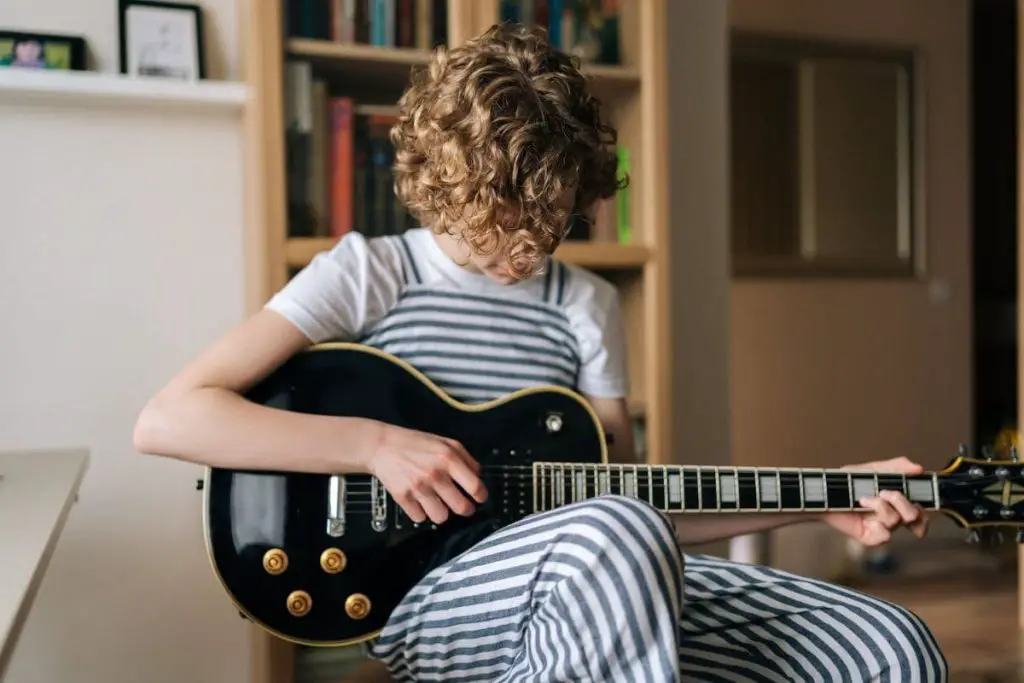
Practice in the Right Room
Practicing in the right room of your apartment can make a world of difference. Not only will you be able to play your electric guitar a little louder, but you also won’t have to worry about your neighbors feeling the vibrations of the amp.
This setup could make a huge difference:
- Consider keeping your practice room near a corner of the house if you live on the edge of the building. This will minimize the noise crossing through shared walls and floors. The vibrations will dissipate into the walls facing the street rather than going into your neighbor’s home.
- Keep all of the windows closed in the room to prevent sounds from getting out. Opening the windows will drastically increase the sound of your electric guitar and the amplifier. If it’s too loud, the sound will go right out of your window and into the neighbor’s windows (or several nearby apartments).
- Always practice your electric guitar away from shared walls. We suggest keeping the amplifier away from the wall as a courtesy. The vibrations and noise will be too much for most neighbors, regardless of the time of day. You can play the instrument by the wall, but make sure the speakers are as centered as possible.
- Don’t play in a room that echoes too much (if you do, consider putting furniture and other items in the room). Bathrooms, hallways, and rooms without a lot of items echo more than usual. You can naturally reduce the sounds and vibrations by hanging wall art, putting chairs in a room, and putting a few pillows near the walls.
- Think about the rooms where your neighbors are likely to be. For example, your bedroom is likely over or under their bedroom. If you’re playing earlier or later in the day, you might want to consider moving to the living room or kitchen, where people are more likely to be active, awake, and less concerned about your music.
Keep Your Amplifier Off the Floor
Amps produce a whole lot of noise and vibrations. They’re the loudest part of playing an electric guitar. Lefty Fretz recommends keeping your amp off the floor to prevent those vibrations from getting into your neighbor’s apartment. Even if you live on the lower story, the vibrations can travel up the walls and into nearby rooms.
Another option is to prop your amp on a few books, a pillow, or a coffee table. These items aren’t as effective as a layer of soundproofing foam, but they can help reduce the vibrations. Furthermore, they’re inexpensive, and you likely already have one or more of them in your apartment. You could also place the amp on an office desk or chair.
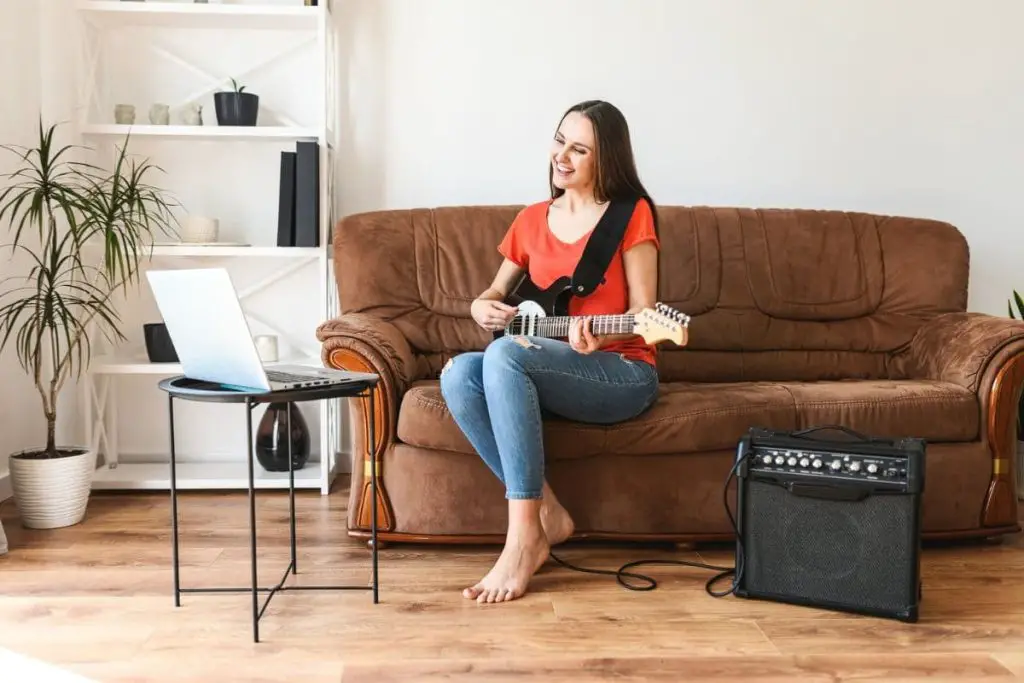
Play With Headphones in the Output Jack
Consider these methods of playing with headphones:
- Plug your headphones directly into the guitar’s mini-amp. If you have a mini-amp, plug it into the electric guitar, then plug your headphones into the 3.5mm jack. Some mini-amps have inputs for headphones, making them perfect for those who want to practice their electric guitars in an apartment.
- Connect your headphones to an audio interface. Audio interfaces serve as middlemen for electric guitars that connect to computers and headphones. Plug your guitar into the audio interface, then plug your favorite pair of headphones into the AI’s headset jack. Make sure you know which kind of jack the AI works with.
- Use the headphones with your amplifier. Much like audio interfaces, you can plug your headphones into an amp. Look for the amp’s headphone input, then find a headset with the corresponding jack. You can adjust all of the sound elements coming through the headphones with the amp.
- Attach the headphones to a laptop or desktop computer. Plug your guitar into the computer with a USB cable or an audio interface, then plug your headphones into the computer. You may or may not have to use a digital audio workstation, depending on your computer’s updated software and operating system.
Playing with headphones will let you hear all of the details of your music without disturbing the neighbors. Remember to choose high-quality headphones if you want to get the most out of your electric guitar. You can also use an audio interface with multiple inputs if you want to sing with your music recordings.
The OneOdio Wired Over-Ear Headphones plug into your guitar, amplifier, or audio interface. They have soft cushions for comfort paired with crystal-clear audio. These headphones come with multiple jacks to fit almost any input you’ll come across. They also have an in-line microphone with play, pause, and selection features.
All apartment buildings have shared walls. Whether you share walls with neighbors on three sides or one side, you’re bound to be connected to other occupants. Furthermore, you might have neighbors above or below you (or both). Be mindful of where you play the electric guitar, and consider keeping the amplifier away from those walls.
If you live in a studio apartment and you can’t play in a room without shared walls, follow some of the sound insulation tips below. You’ll learn about using furniture, rugs, soundproofing foam, and other items to your advantage. Proper placement of furniture and decorations is often more than enough to reduce the audio coming from your electric guitar.
Quick Note: If you’re worried about annoying your neighbor with your acoustic guitar, inform them what times you usually practice. They’re less likely to be frustrated or file a complaint if you’re courteous and approachable. You could also ask them to come to you with any concerns rather than going to the front office.
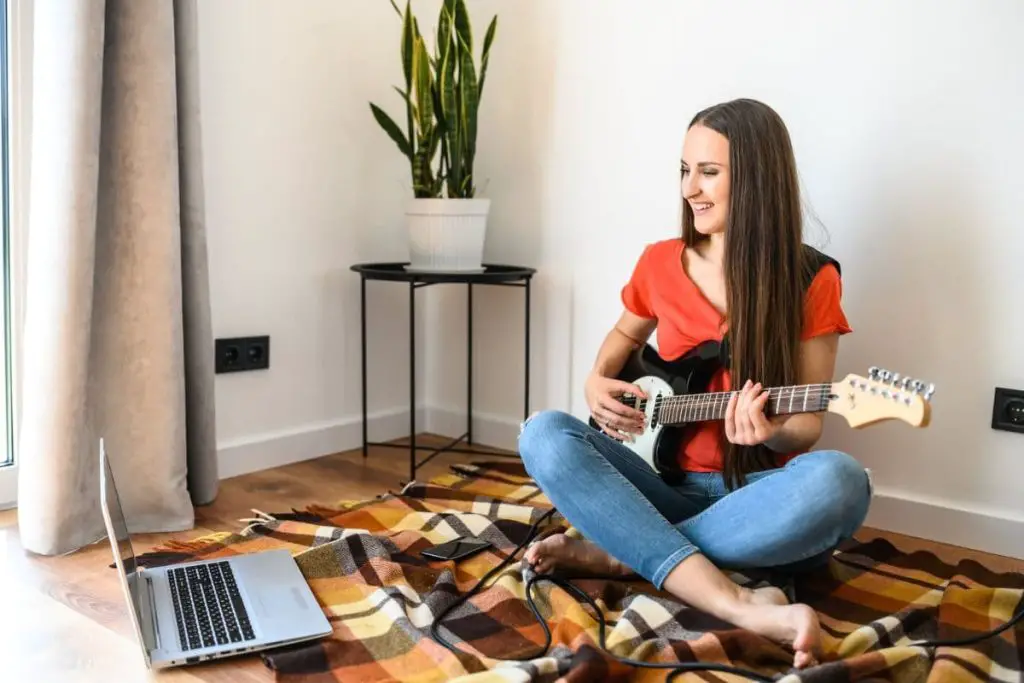
Get a Thick Rug in Your Practicing Room
Consider these specifications to choose the perfect rug for your electric guitar room:
- Make sure the rug is thick enough to prevent as much noise as possible. The thickness helps a lot with soundproofing a room. The more space and distance a sound has to travel, the weaker it’ll get. This simple trick helps much more if you get a rug that’s at least one to two inches thick.
- Dense weaves deaden the sound much more than loose rugs. Density is the main enemy of soundwaves. Soundproof fabric can be thin, but it’s perfect if it’s dense enough. Choose a carpet or rug that’s as dense as possible if you want to prevent the sounds and vibrations from getting into the neighboring apartment.
- Choose a rug that covers as much of the floor as possible. Much like soundproof foam, fabric, and blankets, it’s important to cover the floor from one edge to the other. It’s not nearly as effective if there are gaps in the rug or if the area around the rug is too big. Try to make the rug snug against the walls.
- Always play your electric guitar with the amp in the center of the rug. If you use an amp without headphones, keep your amp in the middle of the room. It’ll disperse as many vibrations and sounds as possible. Take this suggestion a step further by putting the amplifier on a small table or pillow to keep it off the floor.
- Consider getting a layer of soundproofing fabric to put under the rug. Soundproofing fabric is an additional dense layer that deadens the sound. It also prevents the carpet from sliding around the room, which means you don’t have to worry about gaps that could let sound into the apartment below you.
Combining a thick, dense rug with soundproof foam found in the next section will make it almost impossible for your neighbors and roommates to hear you playing electric guitar. However, it’s important to remember that the instrument’s vibrations can cause issues, too. Consider turning down the bass and volume if necessary.
Install Soundproof Foam
Here’s what you should know about using soundproof foam:
- Make sure there aren’t any spaces between the foam. All gaps are spaces for the sound to get through the walls, ceilings, and floors of your apartment. The insulation should overlap or touch without spaces in the middle. Consider using compressed foam to limit the possibility of being too loud.
- Thicker, denser foam has much more of a soundproofing effect. As mentioned above, density slows or stops soundwaves in their tracks. Dense, high-end foam is more than ideal for soundproofing a recording studio or a bedroom to play your electric guitar, regardless of if you live in an apartment or a house.
- Choose a high-quality foam to get the most benefits. Low-quality foam falls apart easily and slowly wears down. While it might get the job done when you install it, it’ll quickly lose its effectiveness over the weeks and months ahead. You’ll spend more in the long run on replacements and repairs.
- Consider covering the ceiling, too. You can put soundproofing foam wherever you want. Keep in mind that the entire ceiling can trap and move the vibrations coming from an amplifier. Covering the ceiling with sound insulation foam will make the wall insulation exponentially more effective.
- Don’t forget to soundproof the door if necessary. You can put sound insulation foam on the door, but you can also use soundproof blankets, snakes under the doorframe, and more. There are plenty of ways to soundproof a door, and it drastically improves the insulation you already have on the walls.
Be Mindful of Your Apartment’s Quiet Hours
Apartment quiet hours are essential. If you want to avoid front office complaints and angry neighbors, it’s best to avoid playing your electric guitar through amps and other speakers at night and early in the morning. Integraudio suggests unplugging your electric guitar from the amplifier and playing without speakers if you want to play late at night.

Keep these quiet-hour tips in mind:
- Most apartments have quiet hours between 9 PM to 8 AM, though these times can vary. Check your apartment’s quiet hours to know when you’re allowed to play your electric guitar through an amplifier. Keep in mind that being too loud during any time of day can lead to unwanted noise complaints.
- Use headphones and avoid amps during quiet hours. There’s no need to be too loud if you don’t want a noise complaint. Electric guitars are quite quiet when they’re used with headphones. You’ll only hear the sounds of the strings, which don’t vibrate through a sound hole as they do with acoustic guitars.
- If you’re determined to play your electric guitar during quiet hours, unplug it and play lightly. As you read above, your electric guitar likely doesn’t have a sound hole where the noise resonates. Strumming and picking the strings simply makes the initial sound of the string, but nothing is amplified.
- You can use light strings and thin picks to reduce your guitar’s sound output. Light strings make any guitar quieter. They weigh less, which means they send fewer vibrations through the guitar. You can also switch to thin, lightweight picks because they reduce the vibrations, too.
Play Through a Digital Audio Workstation
Digital audio workstations (DAWs) are designed to help you play and record various instruments through a digital interface. For example, you can plug an electric guitar into a computer through a MIDI cable or a USB jack. Open a DAW (such as Garage Band) and start playing your electric guitar through it.
Try this in-depth guide:
- Connect your electric guitar to an audio interface for the best clarity. Audio interfaces pull the electrical signals from your guitar. While you can record through a DAW without an audio interface, you won’t get the same high-quality sound. Furthermore, you won’t have as much control over the editing process.
- Open a digital audio workstation. You can choose Audacity, Garage Band, and many others. A digital audio workstation lets you record, edit, and control everything that relates to your electric guitar. You can also play through the DAW without recording anything if you turn on the monitoring option.
- Adjust the various sound elements (bass, treble, etc.). Digital audio workstations let you cycle through numerous options. You can make your electric guitar sound bassy, treble-packed, or like it’s from the ‘80s. It’s up to you to customize the ultimate sound output, whether it’s through headphones or speakers.
- Turn down the volume, strum your electric guitar, then slowly turn it up. Don’t start with the volume too loud, or you’ll end up blowing out the speakers and upsetting your neighbors. Some digital audio workstations are much louder than others, so it’s important to start it at the lowest volume.
- Plug in your favorite speakers if you want a bit more volume. Make sure you don’t use the speakers when it’s past the previously mentioned quiet hours. Most modern speakers won’t get as loud as amplifiers, but they can definitely produce enough volume to cause problems with apartment neighbors.
Grab an Attenuator
Perhaps one of the best suggestions for those with amps is to connect an attenuator. Gear Aficionado explains an attenuator can drastically reduce your electric guitar’s noise output without reducing its quality. You’ll have all of the high-quality sounds of a full-volume amp without the loud noises and vibrations.
Attenuators come in all shapes and sizes. Find the one that best suits your electric guitar, and you’ll be more than happy with the results. There’s no need to sacrifice your practice sessions or limit your audio clarity. Attach the attenuator to the amp, turn them down all the way, then slowly increase the sound until it’s at the right point for you and your apartment.
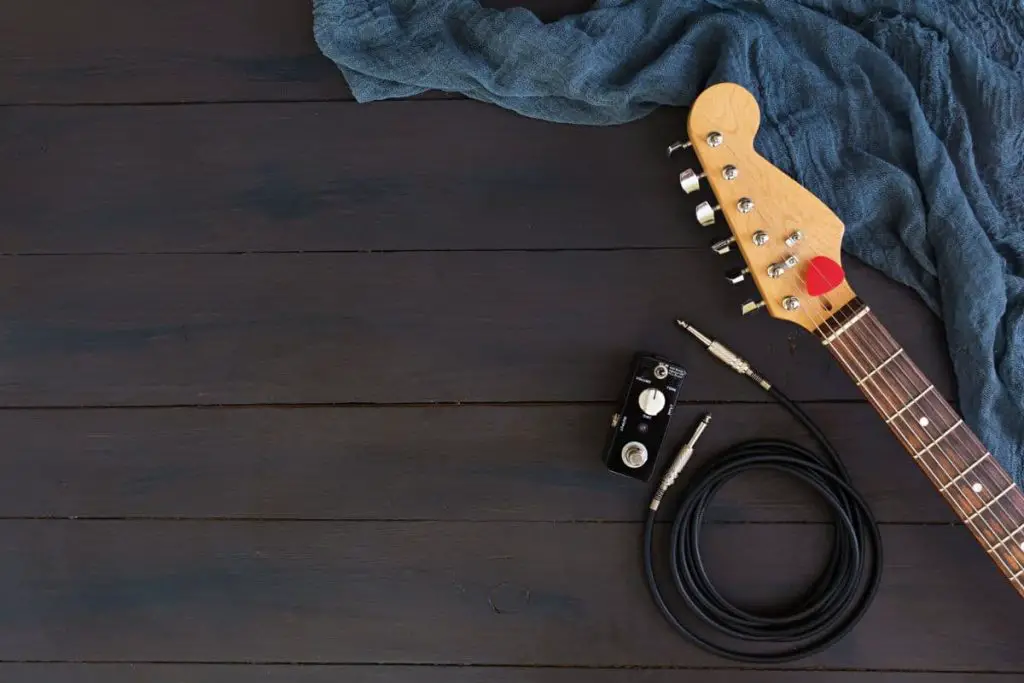
The Donner Amp Attenuator is a foot-activated device that lets you control the amp’s quality and volume. Attach it to your electric guitar and the amp for instant results. It comes in multiple sizes, all of which let you control and mute the device with your foot or hand.
Final Thoughts
There are more than enough ways to play an electric guitar in an apartment. You don’t have to silence the instrument or keep it unplugged if you have one or more of the devices mentioned above. Be aware of the quiet hours and shared walls, and you shouldn’t have a problem enjoying the electric guitar.
👇😀👇NOTE👇😀👇
If you want to find out what my recommended guitar gear is, then here is what I recommend on Amazon:
- Fender Cutaway Acoustic-Electric Guitar Bundle (MY FAVORITE GUITAR)
- Snark SN-8 Super Tight All Instrument Tuner (Easiest Tuner I’ve Used😏)
- 6 String Acoustic Guitar Capo (Best CAPO for quick changes)
- Dunlop Max Grip 1.0mm Nylon Picks (Thick Guitar Pick So You Don’t Lose Grip!)
- Universal Guitar Stand (Cheap & Minimalist Guitar Stand I Recommend)
- Levy’s 2″ Wide Quick Adjust Guitar Strap (Best Guitar Strap For Any Level)
Related Posts:

